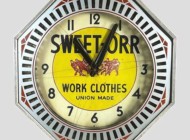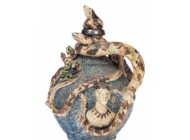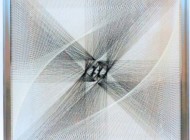-707x1024.jpg)
A Navajo/Dine Germantown blanket from 1904 with 12 sampler panels sewn to create one large textile (75 by 59 inches) that earned $4,375 had been created in 1905 as a bedspread in Princeton dorm room, according to catalog notes.
Review by W.A. Demers, Photos Courtesy John Moran Auctioneers & Appraisers
MONROVIA, CALIF. – Moran’s Art of the American West auction conducted on August 31 featured collections of artwork, American Indian silver jewelry, sculpture in both bronze and silver, turn-of-the-century Navajo textiles, basketry, beadwork and pottery as well as a selection of Stickley furniture and western items. Roping the sale’s highest price, $13,000, was an oil on board by contemporary artist Jason Rich (b 1970/71) titled “Working Sun to Sun,” 2011. The scene of a cattle roundup was signed lower left J. Rich; signed again, titled and dated verso and measured 25¼ by 30½ inches. Rich’s “Closing In,” 2014, an oil on board depicting a cowboy lassoing a young steer, sold for $4,063. Signed lower right J. Rich and signed again, titled and dated verso, the 12-by-10-inch painting had been exhibited at the Autry Museum of the American West, “Masters of the American West Fine Art Exhibition and Sale” in early 2014.
Rich knows whereof he paints. He grew up riding, training and drawing horses on a small farm in southern Idaho. His interest in art was fostered at a young age, which led him to study art at Utah State University where he received bachelor and master of fine art degrees. Having established himself in the art market, he has enjoyed much success and recognition in prestigious organizations, shows, events and elite publications. “Working Sun to Sun” sold to a private collector in the United States, according to sale specialist Maranda Moran, who added that the contemporary images of working cowboys in the sale were a great tonic to counteract both the anxiety and ennui of living in the age of Covid. These cowboys wear bandanas but not to ward off virus, they are masters of working outdoors. “For those of us stuck inside at computers, it’s great to see these folks out on the range,” she said.
Moran said the sale totaled about $330,000 with 98 percent sold by value and a 95 percent sell-through. The auction house partners with Invaluable for online bidding on its own platform, and there were 1,400 registered bidders participating there, not counting those bidding on LiveAuctioneers. “Historically, we’ve offered material that tends to be more turn-of-the-century, and this was a change for us,” said Moran. “Most all of the textiles, jewelry, pottery and bronzes were contemporary, so I was cautiously optimistic but pleasantly surprised that things that were more decorative did exceptionally well.”
-1024x851.jpg)
Roping the sale’s highest price, $13,000, was this oil on board by contemporary artist Jason Rich (b 1970/71) titled “Working Sun to Sun,” 2011.
“Range Management” was the title of a 2011 oil on canvasboard by Arizonan Bill Anton (b 1957). Fetching $10,625, the 16-by-20-inch painting of a cowboy astride his horse supervising grazing cattle in the foothills was signed lower right, signed again and with the copyright symbol, titled and dated verso. It had been shown at the Ponderosa Art Gallery, Hamilton, Mont. Born and raised in Chicago, Anton became a western painter, especially of the lifestyle of cowboys. He first traveled west at age seven.
Native Americans of the West were portrayed well in two oil on canvas board works by California artist Z.S. Liang (b 1953). Each finishing at $6,875 were “Hunkpapa Scout,” 2013, 12 by 9 inches, and “The Scout,” 2012, also 12 by 9 inches. Both had been acquired by the consignor from Trailside Galleries, Jackson, Wyo. Z.S. Liang was born in China and raised in a family of artists. He studied at the Central Academy of Fine Arts in Beijing and Guangzhou Academy of Fine Arts. He has a passion for the Native Americans as a people coupled with a keen sense of historical accuracy, storytelling abilities and exceptional drawing skills, which add strength and truth to his portrayals.
Also with Trailside Galleries provenance was “War Ponies Crossing the Bighorn,” 1913, a bird’s-eye view by Richard D. Thomas (1939-2019) depicting the horses fording the stream, shepherded by two braves in warpaint and feathers. The oil on board measuring 30 by 20 inches was signed, titled and dated and went out at $5,625.
Other notable fine art highlights in the sale included “Desert Hideaway,” 1961, an oil on board by John W. Hilton (1904-1983) depicting an oasis view amid a harsh landscape, which brought $7,500; another by Hilton, titled “Plowman,” an oil on canvas depicting a lone farmer trudging among fresh furrows, 30 by 25 inches, that left the gallery at $4,063; and a “Profile of a Native American Chief,” 1904, by Edgar Samuel Paxson (1852-1919). The latter, bid to $5,938, was a watercolor on paper under glass, 12¼ by 10 inches, signed and dated lower right.
The sale featured two large collections of American Indian silver jewelry with large selections of ketohs, bolos and other jewelry by both historical and contemporary silversmiths. A Thomas Curtis Sr (Navajo/Dine, Twentieth Century) silver bolo and buckle, each stamped T. Curtis / Sterling, comprised a heavy round bolo with double sets of ferrules and cylindrical tips suspended from a braided black leather cord with a matching buckle. Totaling 359 grams, the bolo/buckle took $8,750, well above its $800-$1,200 estimate. “Just quintessential design, both weight and tooling,” said Moran.
Selections of sculpture in both bronze and silver from esteemed artists Earle Heikka, Bud Boller, Don Pollard, James Regimbal and Stan Johnson were offered. Notable were Regimbal’s (b 1945) “Trailn’ Home,” 1984, a cold-painted bronze of a cowboy leading a procession of pack horses, that sold for $7,500 and “Sassy,” a cold-painted bronze on rotating wood base by David Lemon (Montana, born 1945) depicting a working cowgirl with true grit and lasso in hand. Commanding $6,250 and edition 10/80, the sculpture was signed, titled to plaque and measured 18 by 10 by 5½ inches.
-954x1024.jpg)
A Thomas Curtis Sr (Navajo/Dine, Twentieth Century) silver bolo and buckle, each stamped T. Curtis / Sterling, took $8,750, well above its $800-$1,200 estimate.
Turn-of-the-century Navajo textiles, basketry, beadwork and pottery as well as a selection of Stickley furniture and western items rounded out the sale’s highlights. From the second quarter of the Twentieth Century came a Lekeeya carved stone fetish necklace that more than doubled its low estimate to bring $5,000. Comprising 21 stone fetish animals, carved from mother-of-pearl, turquoise, abalone and onyx, separated with tubular coral bead spacers and with metal clasp, the 14-inch-long necklace was formerly in the McCormick collection of American Indian art and had been sold at auction from that collection in 1974. The lot was accompanied by a second-place ribbon from the Intertribal Indian Ceremonial dated 1956.
A Navajo/Dine Germantown blanket from 1904 with 12 sampler panels sewn to create one large textile (75 by 59 inches) comprised two whirling logs, two cross motif panels and a red and green whirling log on a black field. It earned $4,375. Property of Colonel Robert C. Wallace of Southern California, through decent in the family, the blanket came with an interesting catalog note stating that “the individual samplers were selected by the purchaser to create a bedspread in his Princeton dorm room in 1905. Apparently, Navajo textiles were the fashion of the day for Princeton alumni.”
Also from the first half of the Twentieth Century was a Sioux beaded hide ceremonial dress with a polychrome beaded yoke in red, white, green and yellow with a porcupine quill-embellished fringe and trade bead tassels. It went out at $4,063.
Leading the Gustav Stickley furniture on offer was a Number 711 desk (sans key), circa 1901-16, with Stickley shop mark of a joiner’s compass that sold for $4,688. The fumed oak desk had a rectangular top over a central drawer, flanked by two writing slides above a series of drawers with hammered copper pulls. Raised on eight straight legs, the desk measured 60 by 32 by 29¾ inches.
Prices given include the buyer’s premium as stated by the auction house. Moran’s next Art of the American West sale is set for November 30, while the firm’s sale of Modern and contemporary art will be conducted September 14.
For information, 626-793-1833 or www.johnmoran.com.

.jpg)
.jpg)
.jpg)
.jpg)
.jpg)
.jpg)
.jpg)
.jpg)
.jpg)
.jpg)
.jpg)
.jpg)
.jpg)
.jpg)
.jpg)
.jpg)



